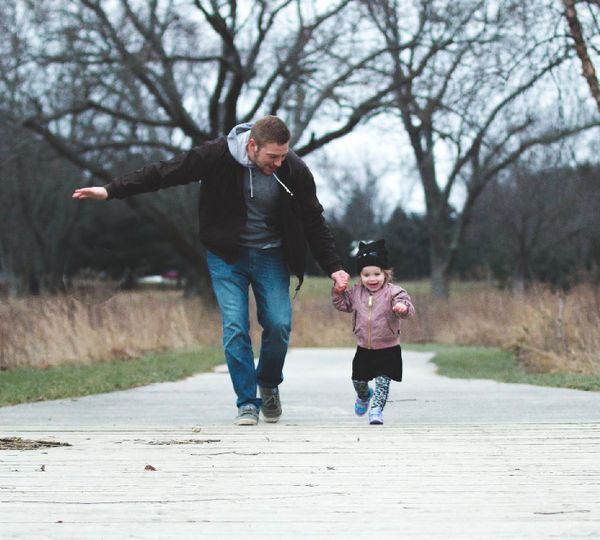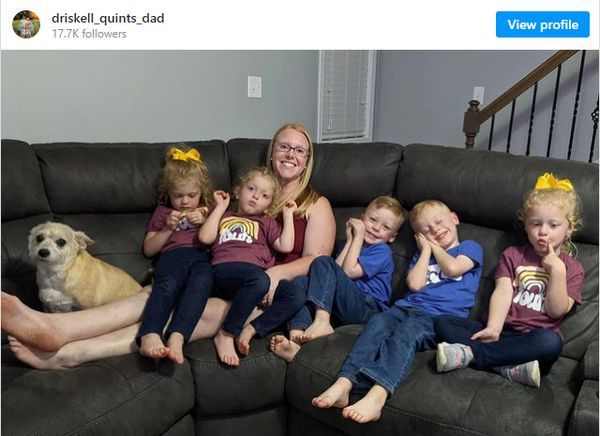Parenting is a journey that presents its own set of challenges, especially in today’s world where judgment seems to lurk around every corner. But for Jordan Driskell, a 31-year-old father, the challenges are certainly multiplied. He is the proud father of five quintuplets, all five years old. Raising five children who are the same age is no easy task, especially when their curiosity and love for exploration can sometimes lead to chaotic situations, particularly in public.

To tackle this unique challenge, Driskell came up with a creative solution: leashes designed specifically for children. These leashes not only ensure the safety of his energetic bunch but also allow them the freedom to explore their surroundings under their father’s watchful eye.
In the past, the Driskell family relied on a stroller with six seats for their outings. However, the kids would often get restless and bored inside the stroller, making it difficult to enjoy their time outdoors. The stroller didn’t provide the same level of freedom and movement that the children craved. With the introduction of the leashes, the family can now enjoy outings without compromising the children’s need for exploration and movement.
Despite the benefits of using leashes, Driskell faced unexpected backlash when he shared a video of their trip to the aquarium. The video went viral, attracting over 3 million views and numerous negative comments. Critics argued that children shouldn’t be put on leashes because they are not animals, while others questioned Driskell’s ability to handle the pressure of raising five children.
However, parenting and adolescent development specialist, Dr. Deborah Gilboa, offers a different perspective. She believes that using a leash for young children, especially those with neurological differences, is an effective way to ensure their safety in public spaces. Dr. Gilboa emphasizes that a leash doesn’t make a child feel like an animal; rather, it provides parents with a means of control while allowing their children the freedom to explore their surroundings.
Dr. Gilboa does acknowledge that by the ages of eight or nine, neurotypical children should have developed enough independence and listening skills to navigate public spaces without the need for a leash. At this point, parents should be able to communicate verbally with their children, without relying on devices like leashes.
Parenting is a deeply personal journey, and each parent should have the freedom to choose the methods that work best for them and their children. Unnecessary judgment from society only adds to the challenges parents already face. It’s important to remember that what may work for one family may not work for another. So, what do you think about children on leashes in public? Let us know in the comments below and feel free to share this article with your friends and family to hear their thoughts too!
Raising children in today’s world poses its own unique set of challenges. For Jordan Driskell, a father of five quintuplets, these challenges can be particularly daunting. With all five children now five years old, there is no doubt that life is full of excitement and curious exploration. However, this can also lead to stressful situations, especially when venturing out in public.
To overcome this, Driskell came up with an ingenious solution: child leashes. Designed specifically for children, these leashes provide both safety and the freedom for exploration. It’s not about treating children like animals; it’s about giving them a sense of security while allowing them to navigate their surroundings at their own pace.

Gone are the days of relying on a cumbersome stroller with six seats. Driskell found that his children would often become restless and bored, making any outing a hassle. The leashes provide a convenient alternative that caters to their need for movement and adventure.

While Driskell faced some unexpected criticism after sharing a video of their exciting trip to the aquarium, parenting and adolescent development specialist, Dr. Deborah Gilboa, offers a different perspective. She believes that leashes can be an invaluable tool for ensuring the safety of young children, especially those with neurological differences. It’s not about limiting their freedom but rather about allowing them to explore while keeping them safe.

Dr. Gilboa acknowledges that as children approach the ages of eight or nine, their independence and ability to listen should have developed sufficiently. At this stage, a leash may no longer be necessary as parents can communicate verbally with their children without relying on physical restraints.

Ultimately, parenting is a deeply personal experience, and each parent should be free to choose the methods that work best for them and their children. Unwarranted judgment from others only adds to the challenges already faced. It’s important to remember that what works for one family may not work for another. So, what are your thoughts on children using leashes in public? We would love to hear your opinions in the comments below. Feel free to share this article with your friends and family to gather their thoughts as well!






